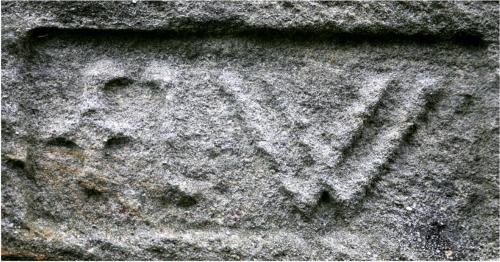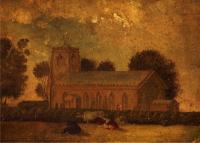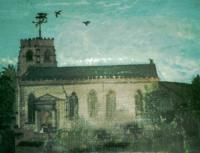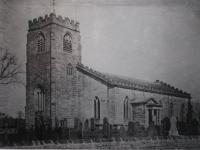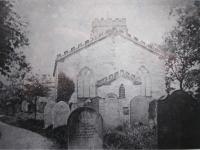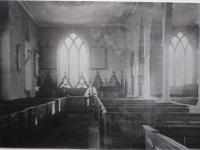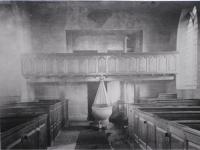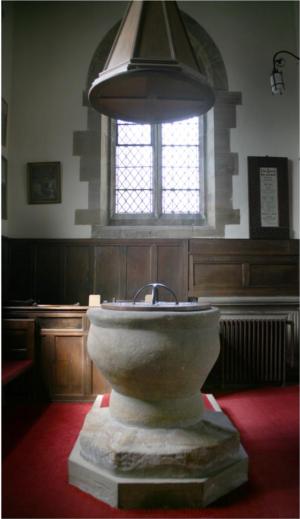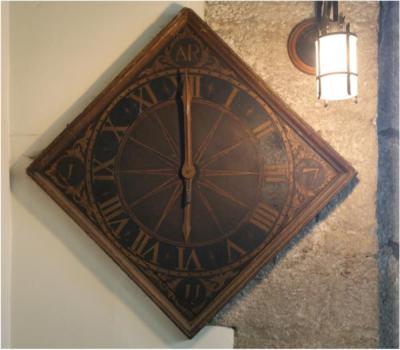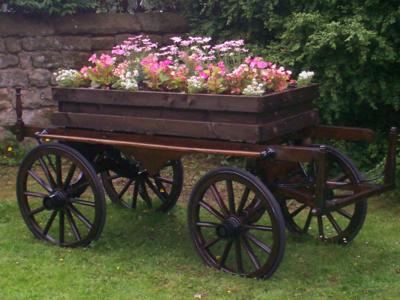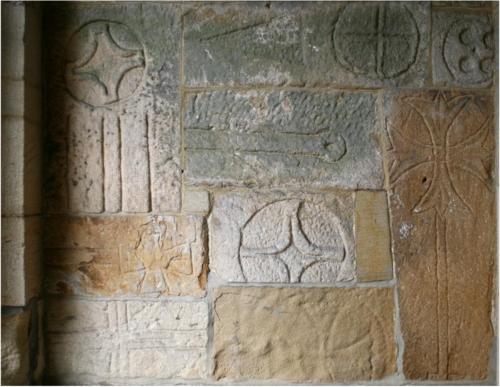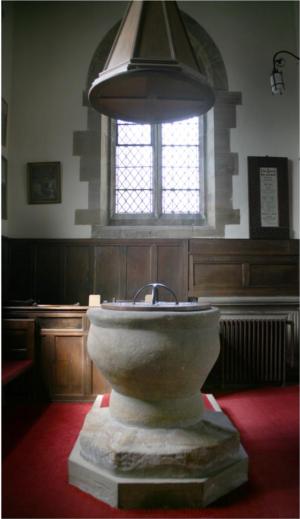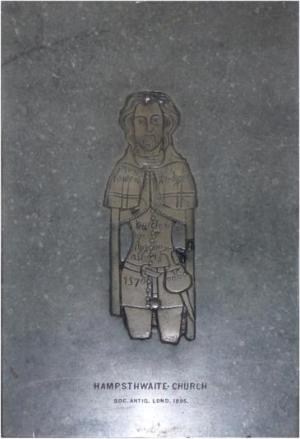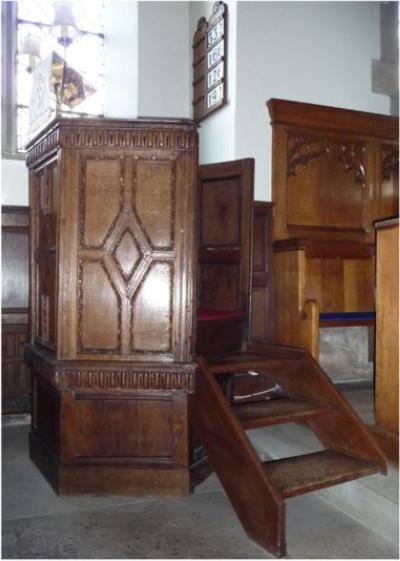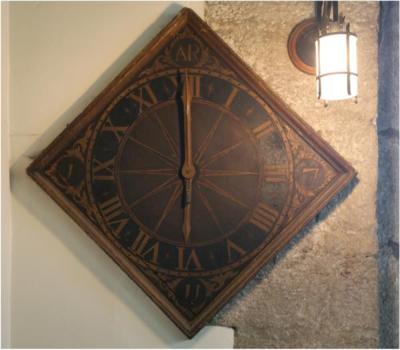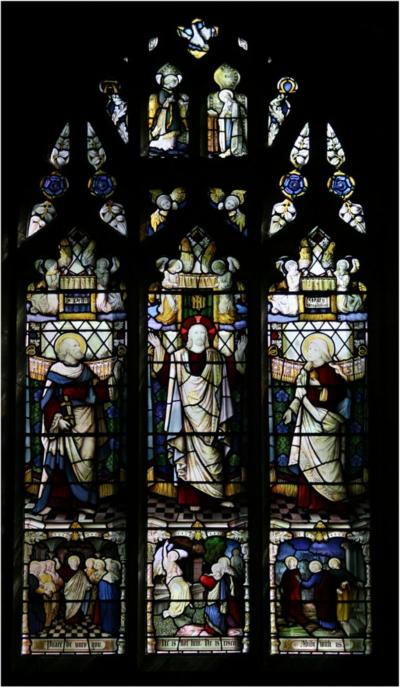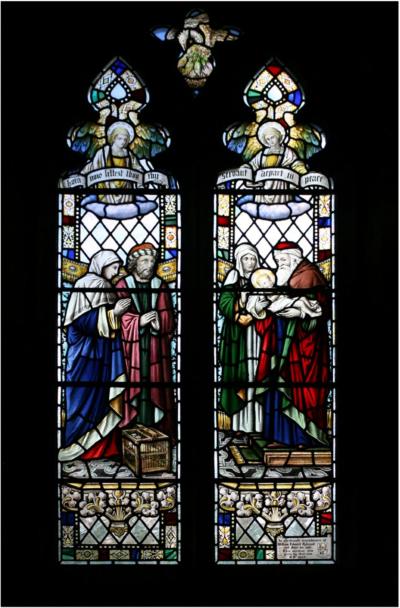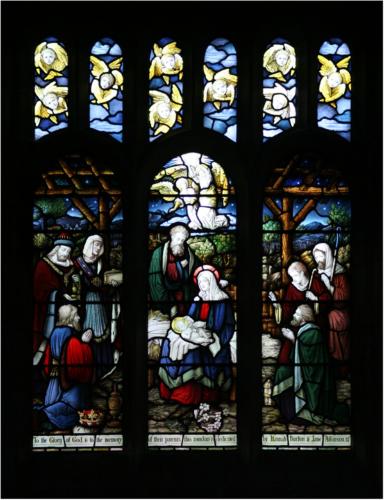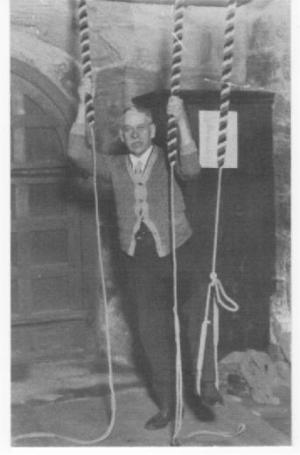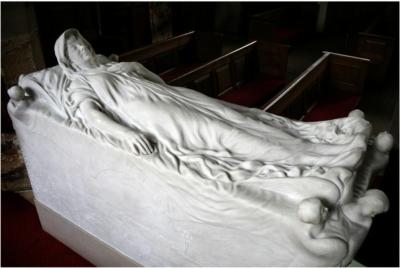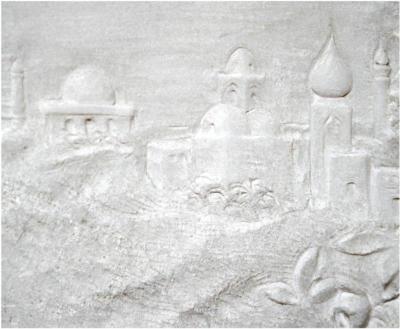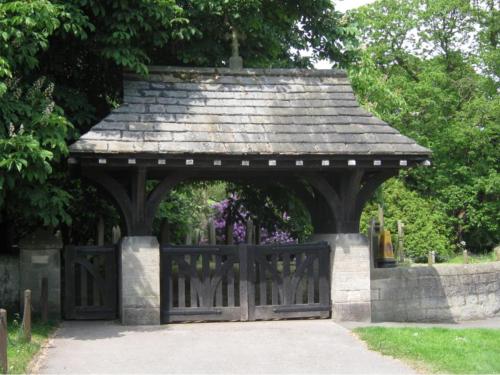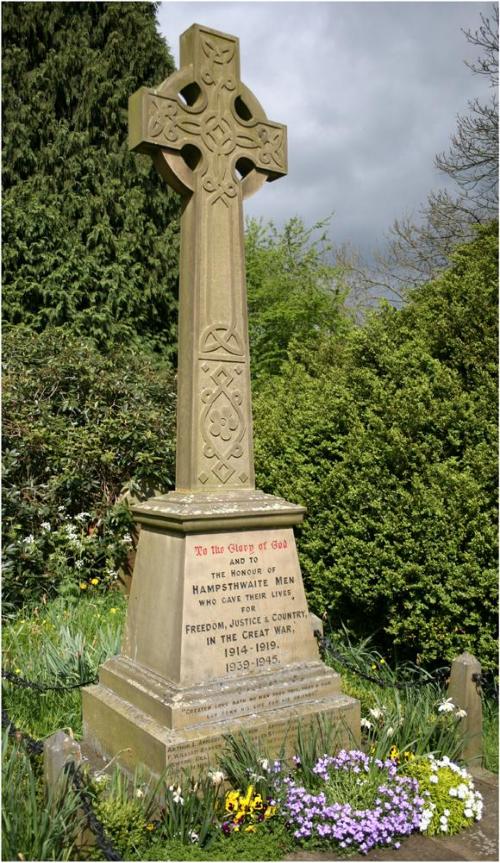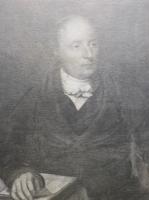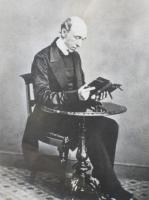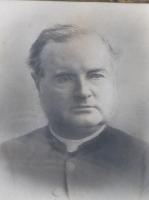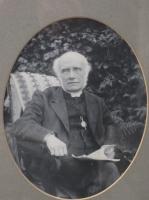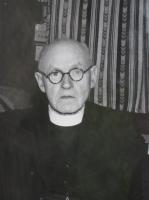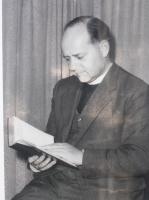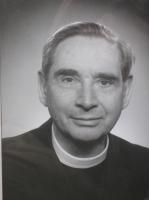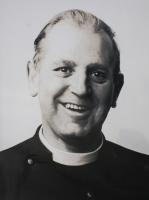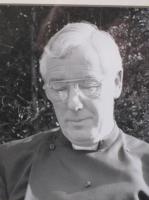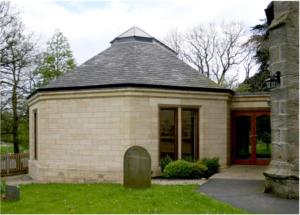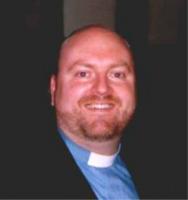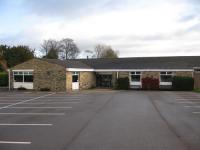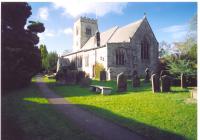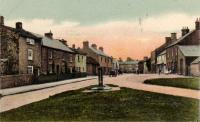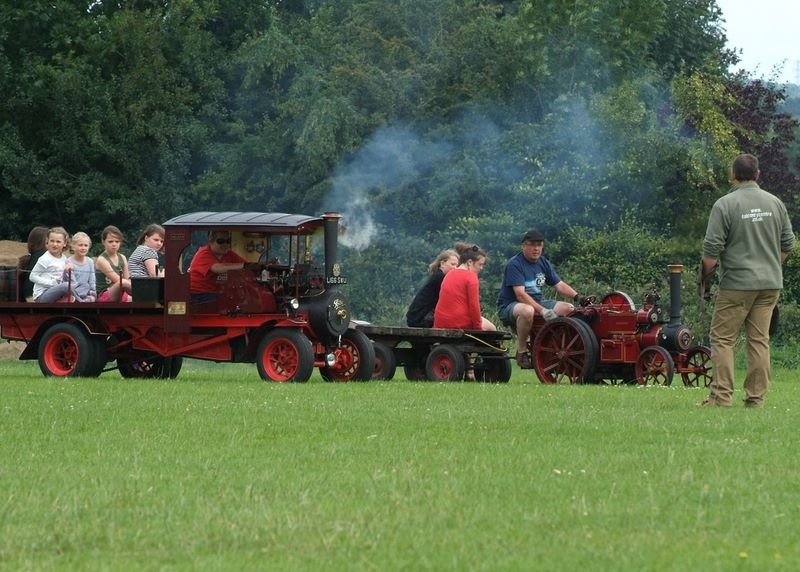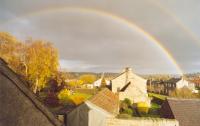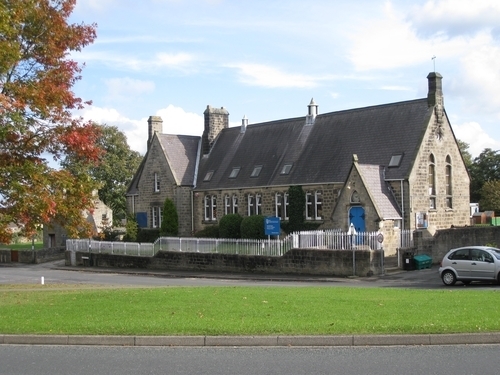Recent articles
© DT Online 2010 - 2025
| The Parish Church of St Thomas a'Becket - Ian HadenIndex
Evidence of a Saxon ChurchThe early history of church life in Hampsthwaite is far from clear and is to some extent based on supposition. The best evidence of its existence in the 5th and 6th centuries lies in the discovery of a number of stone grave covers during the restoration of the present church in 1901. Located beneath the foundations, these were identified as Saxon or early Norman in design and workmanship. Several of them had been incised with crosses in the Celtic style. All have been preserved, the two largest standing adjacent to pillars within the church and the remainder - apart from two recently moved inside the church to prevent further erosion of the stone facing - being set in the walls of the porch. From this discovery it is feasible to deduce that a burial mound existed - and there may even have been a church made of wood on the site. If so, it would have been close to the Roman road from Aldborough to Ilkley, which crossed the nearby river and extended almost the whole length of the parish. So, who was responsible for building the first known church in the village and why was it dedicated to St. Thomas a Becket? The Connection with St.Thomas a'BecketThomas a Becket (1118-1170) was the son of a rich Norman merchant and was ordained by and served under Theobald, Archbishop of Canterbury. In 1155 he was appointed Chancellor of England by Henry II (1154-1189), who was increasingly concerned about the power which the church was exerting in the running of the country. To strengthen his position the king ensured that the high offices were bestowed on his supporters. Thus it came about that he made one of his knights - Hugh de Morville - Constable of Knaresborough and its castle. In an attempt to manipulate the church, Henry made his friend Becket, whom he considered more royal than Roman, Archbishop of Canterbury in 1162. From being subservient to the King, Becket set about ridding the church of its corruption. He obtained the Pope's permission to excommunicate the Archbishop of York, the Bishops of London and Salisbury and some knights. He also opposed the Constitution of Clarendon (1164), by which the King attempted to bring the clergy under the rule of he courts. This made him many enemies and he fell out with the King, who exclaimed: "Will no one rid me of this turbulent priest?" Becket was forced to flee to a Cistercian abbey in France, but he later returned to England to be reinstated by the Pope in 1170. It is not known whether the King was directly responsible for Becket's murder, but by the end of the year bitter hatred existed between them. On the night of 29th December, 1170, four knights - Hugh de Morville, Reginald Fitzpurse, William de Tracy and Richard Le Breton - entered Canterbury Cathedral and murdered Becket in the chapel of the north transept while he was kneeling in prayer. The knights had assumed that they would be pardoned by the King, but so great was the shock as word spread about the dastardly deed that Henry was forced to arrange for their capture. The excommunicated Archbishop of York helped the four knights to escape to Knaresborough, where he knew that Hugh de Morville was Constable of the Castle [1159-1173 Ed]. There they found a safe refuge amongst powerful friends. Later, the four travelled to Rome, where they sought the Pope's pardon. This was granted on condition that they did penance. It is believed that part of Hugh de Morville's penance was the building of a church - dedicated to St. Thomas a Becket at Hampsthwaite. Why was Hampsthwaite chosen, who was responsible for the building and when was it built? The Manors of Aldborough and Knaresborough and the Building of the First ChurchIt was in 1177 that Henry granted the Lordship of the Manors of Aldborough and Knaresborough to another of his friends, William de Stuteville, whose old and influential family had come to this country at the time of the Norman Conquest. Knaresborough Manor controlled large areas of land established by the Normans as royal hunting grounds. The Forest of Knaresborough measured some 100,000 acres and extended twenty miles from east to west. Lordship of the Manors carried the right of local jurisdiction (the "soke") of the properties in the parishes and clearings of Hamps-thwaite and Felliscliffe and extended as far west as Thornthwaite and Padside. There is actual documentary evidence in the Torre's manuscript - kept in the Library of the Dean and Chapter of York - where we find the following extract: "The chapel of Hampsthwaite as appendant (= attached) to the Mother Church of Burgh (= Aldborough) by composition was to pay those unto three bezants (= 3 gold coins) at Pentecost, by the clergy thereof presentable by William de Stuteville and his heirs." The building of the church - thus attributed to William de Stuteville - was probably completed about 1180 and was dedicated to St. Thomas a Becket by William to prove that he had no sympathy with the Archbishop's assassins. He held the patronage of Hampsthwaite until his death in 1203, when he was buried at Fountains Abbey. As he left no male heirs, the Lordship of the Manors was granted first to Hubert de Burgh and later was within the custody of the Archbishop of York. It then reverted to Henry III (1216-1272), who in 1235 granted the Lordship to his brother Richard, Earl of Cornwall. Eventually, he received the patronage from the de Stuteville family. No information has yet been found of the design or size of the first church , which may have been enlarged in the middle of the 13th century by the addition of a south aisle [Original church was probably destroyed when the Scots invaded the Dales after their victory over Edward II at Bannockburn in 1314. Ed.]. Evidence for this? - the base of the pillars which lie two and a half feet below the present floor level and which may have been used as the foundation for the later church, built about 1340-60. What we do know is that in 1257 the patronage of the church passed from the Earl of Cornwall to the Minister and Friars of the Priory of St. Robert of Knaresborough. Who was St. Robert and why should a religious order be made responsible for the clergy at Hampsthwaite? The Priory of St.Robert of KnaresboroughIn 1160 Robert Fleur was born in York, where his father was probably Lord Mayor. He showed an early interest in the monastic life when he became a novice at a Cistercian monastery near Morpeth in Northumberland. Later he left the monastery to become an itinerant monk, travelling in the Dales, where he began to preach to those working on the land. Eventually, he reached Knaresborough where, in a hollow on the banks of the Nidd, he discovered a knight hiding from the King's forces. Robert was invited to stay and, when the knight moved on, he remained at his hermitage and built a chapel there. William de Stuteville regarded the friends visiting Robert as robbers and outlaws, but Robert ignored this and continued to lead a simple life, preaching and healing. His piety became known far and wide and many came to hear him preach and to receive his benediction. Even King John (1199-1216) sought his advice and is known to have made several visits to Knaresborough. In France in 1197 The Order of the Holy Trinity and of the Redemption of Captives in the Holy Land was founded and its members were known as Trinitarian Friars. With each house headed by a Minister, its aims were to preach, teach and minister to the local people and to give alms. They became drawn to the work of Robert and in 1257 the Earl of Cornwall issued a charter, giving Robert's chapel to their order. William de Stuteville continued to persecute Robert and even threatened to have him evicted. The story is told of how William had terrible apparitions in which three fearsome men were attacking him with burning rods and iron clubs. Believing this to be retribution for his cruelty to Robert, he pleaded for his life and promised to atone. He sought forgiveness from Robert, giving him land, cattle and alms for the poor. In November 1257, on the authority of the King and the Earl of Cornwall, the Archbishop of York made an order, which granted to the Ministers and Friars of the Priory of St. Robert the tithes (=local taxes), garbs (=clerical vestments and ornaments) and land belonging to the area. Hampsthwaite was included in this order. It was some time later - in December 1348 - that a licence was granted to the Minister and Friars "to present one of their fellow brethren, expressly professed and constituted in priest's order, to the Vicarage of this church of Hampsthwaite." The only mention of Robert's canonisation is contained in the remission granted by the Pope in 1252 to all those involved in building the Priory. In it there is a reference to the body of St. Robert of Knaresborough, buried there. Rebuilding the Church During the 14th and 15th CenturiesWhat happened to the first church is pure speculation. We know that, after their victory at the Battle of Bannockburn in 1314, the Scots invaded the Dales area and damaged a number of churches. Hampsthwaite Church was probably destroyed in the period 1318-19 and then rebuilt sometime between the middle of the 14th and the beginning of the 15th centuries. The strongest evidence for this lies with the lower portion of the existing tower and the south facing window in the belfry, which belong to the early decorated style of architecture. It is possible that the belfry window was originally the west window of the nave and that it was inserted in the tower where an off-centre split window previously existed. The upper part of the tower is perpendicular in style and may have been added in the 15th century. Of particular interest are the initials on one of the pillars, which are believed to be those of the mason who carved the stone. There are no precise details of the design of the church, but when it was pulled down in 1820-21 it appeared to have been enlarged or altered at least three times. The first building was long and narrow with a high-angled roof, which can be clearly seen inside the church on the east-facing wall of the tower. Some time later the south wall was removed and a side-wall, with a lean-to roof, was built outwards. In place of the south wall the main roof was supported by a row of octagonal-shaped pillars, bearing pointed arches, with the clerestory windows above. The final alteration was to remove the clerestory and to cover the whole church with a single, wide roof. In the south aisle, at the west end, a piscina (=stone basin) was found, above which were two brackets set into the wall. They probably supported some sculptured figures and were part of the chapel (or Chantry) dedicated to St. Mary the Virgin and St. Anne. Rebuilding the Church in 1820-21In 1820, the Vicar - Timothy Metcalf Shand - and the churchwardens sought permission from the Diocese of York to pull down the nave and chancel of the old church, leaving the tower untouched. Presumably, by now the needs of the parish required a larger church. The new one was of poor architectural quality, as may be seen in the four photographs now preserved in the church. It was built to the design of Knaresborough architect Thomas Driffield, who directed the rebuilding work carried out by James Foxton of Ripon. It is reported that Foxton charged £390 and that most of the cost was borne by the rates. The nave and chancel were almost certainly built on the same foundations as the earlier church, but the south aisle was enlarged to a size greater than the combined nave and chancel. New stone was used for the outside, but the inside walls incorporated much of the old stone. Over the whole building a single low-pitched roof was fixed, with its apex placed away from the centre of the tower while, extended right across the tower and ruining its proportions, was the high gable end, the line of which can still be seen today. Inside, the roof was supported by wooden props (nine inches in diameter), which were fixed to the bases of the original pillars. The ceiling was plastered, with six plasterwork decorations, intended to be used for hanging oil lamps. The church inside was austere, with very plain furnishings - and a single stove at the back to provide heat! No doubt everyone made a beeline for it in the cold winter months! At the east end of the church was a small sanctuary, enclosed by a heavy wooden communion rail, while on the wall behind the altar were four wooden tablets, of which two were inscribed with the Ten Commandments (now preserved in the belfry). Both the nave and the side aisle were furnished with high-backed pews, the ends being fitted with wooden doors. Across the area of the tower an oak gallery from the earlier church was refitted. It still bore the original inscription on a plaque: Mr.Thomas Leuty built this loft at his own expense 1725 At the back of the church was the large stone font - thought to be Norman - with a tall cone-shaped wooden cover, recently removed from the tower, repaired, polished and suspended from the ceiling above the existing font.
Above the gallery was a clock with a wooden face and inscribed AR 1711.
The church, described as a barn-like edifice, was clearly too large for the parish and it remained in use for only eighty years. 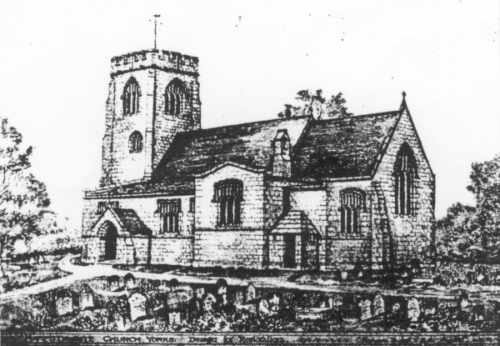 Architect's design for 1901 rebuild
Herbert John Peck came to Hampsthwaite as curate in 1896. Realising that the church was too large for the size of the parish and following the building of three daughter churches at Thornthwaite, Darley and Birstwith, he instituted a restoration scheme to make good the mistakes of the earlier 1820 design. Hodgson Fowler, a Durham firm of architects, drew up the new plans, which involved the removal of the ugly roof and of the walls down to their foundations. It was during the excavation of the building that a number of ancient grave covers and stones - one of which had been used as a base for the south wall - were found.
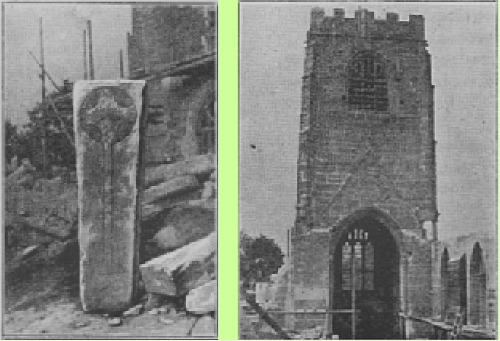 Saxon grave cover and the old tower during the 1901 restoration
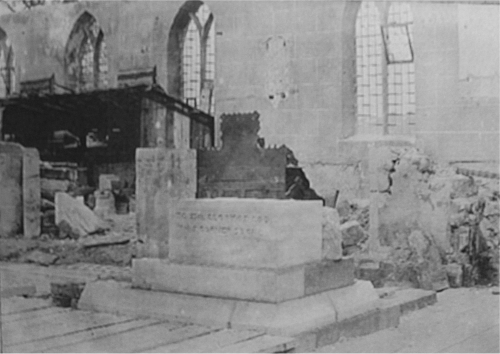 The Foundation Stone
Hodgson Fowler's original design was considered to be too costly. It was, therefore, decided to omit the short transept from the south aisle in the final plans. In spite of the change, the restoration was to produce a well-proportioned building. While its architecture would not conform to any acknowledged style, it is now thought to be similar to the 14th and 15th century building pulled down in 1820. 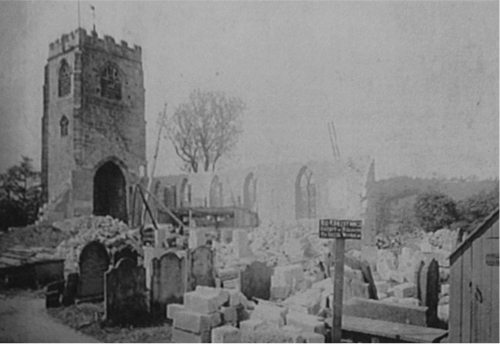 1901 Re-Build
The walls of the nave and chancel were rebuilt on the same site, but the church was made smaller by moving the south aisle inwards by eight feet. New stone pillars were built on to the existing pedestals, which were topped by arches to support the roof. They gave a much improved outside appearance, as the tower was no longer dwarfed by the roof - and the nave and aisle were in proportion. 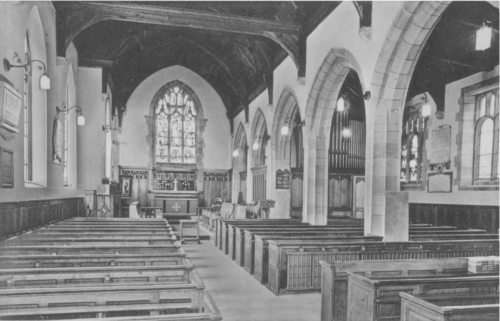 Interior of the rebuilt church
Inside, the gallery at the west end was taken down to reopen the tower arch. All the old pews were removed, their wood being used for replacement ones and for facing the inside wall. The oak panelling from the front of the former gallery formed the first pew in front of the lectern. John Haxby, the village joiner and parish clerk, carried out all this work with considerable skill. Some repairs were made to the Jacobean pulpit and it was remounted on a new stone base. Similarly, a new octagonal stone base was made for the large stone font. 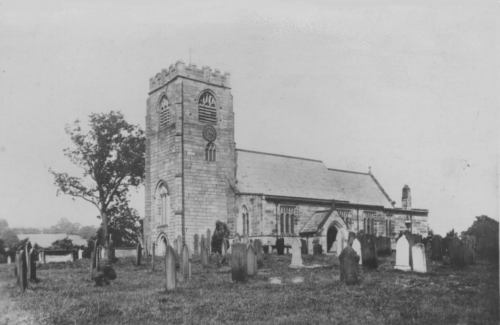 Church with lead roof
Raising Funds for the RestorationAs soon as he became vicar in 1898, Canon Peck set about raising money. In two years he collected £1,810 to pay for the restoration. A further £600 was still needed for the purchase of a number of additional items and a committee was formed to seek gifts from local benefactors. The committee comprised the vicar, the churchwardens and a number of influential people from the county, including Captain C.S. Greenwood (Swarcliffe), Mr. H.C. Shann (Tadcaster), Mr. W. Sheepshanks (Arthington Hall) and Mr. T.D.R. Wright (Hollins Hall). The cost of the outstanding items makes interesting reading today:
There were also a number of other items not included in the above estimate:
The Great BazaarTo raise the additional money a two-day bazaar was held in the Winter Gardens, Harrogate on October 15th and 16th, 1901 from 2.30 to 10.00pm. Two bands played each day and entertainment "of mirth and merriment" was provided. A dozen stalls were set up, selling china, glass, art, Indian and fancy goods, fruit, plants and refreshments. Items made by church working parties in the parish were also on sale. A number of quaint competitions had been arranged, including the Ladies' Monkey Brand Polishing and the Gentlemen's Needle Threading - both detailed in the bazaar brochure. For the polishing, each competitor was provided with a tablet of Monkey Brand Soap and a cloth and, on the word "go", had to polish pennies. The lady who polished the most in five minutes won the prize. "Speed and correctness of detail" were decided by "judges of known repute" and "points were deducted for irregularities". In the needle-threading, prizes were awarded to those gentlemen who threaded the most needles in five minutes. It was an impressive and successful occasion, which allowed the restored church to be opened free of debt. On the framed notice in the Baptistry, we read that the final cost was £2,730, all of which was raised by public subscription, with nearly forty names on the printed list. Some Aspects of the Parish in the 18th and 19th CenturiesThe TerriersOne of the principal sources of information on parish life in the 17th and 18th centuries is provided by the Terriers (surveys of land and properties). Two interesting surveys are those of 1743 and 1817. The first was made during the incumbency of Edward Bainbridge (1738-1771), when Thomas - Archbishop of York - held a visitation in Leeds on 23rd June, 1743. Some details are given of the Property and Tithes of the benefice. Referred to are the size of the Vicarage (24 yards x 10 yards) and the existence of a barn, stables and cow house, along with two gardens and an orchard. The vicar's income came from tithes (= one tenth part) on hay gathered from land in the village and from lambs, wool, pigs, fowl and fruit. He was entitled to fees of 4/- per annum from Hill Top Farm and from Darley Mill - an indication of the size of the parish. Where the hay tithe was payable in kind, the vicar received 1d - and at Easter every householder or tenant was obliged to pay 4d in lieu of tithe fruit and eggs. The same Terrier gives a list of the furniture and utensils of the church, some of which (see *) are still in existence:
In the vestry were a table, a chest and a press, a book of homilies, a book of Common Articles-Injunctions, two surplices, an academic hood and *four boxes to receive alms. Since there were only two prayer books, the congregation recited from memory. The vicar was robed when taking the service and may have preached from the book of homilies. That only two chalices were made of silver signifies that benefactors of the church were yet to emerge. The second Terrier refers to the visitation by Edward, Archbishop of York, at Skipton on 18th August, 1817. It also gives some details of the sources of income received by the then vicar, Timothy Metcalf Shann (1790-1839): he was entitled to rents charged by the Commissioners to Hill Garth Farm, Darley Mill, Wreaks Mill and coplands (= a tenure less than freehold) through- out the parish. In addition to the customary 1d for every house in Hampsthwaite, he received 4d for every house in the rest of the large parish and also 2d from every parishioner of sixteen years and over. It lists the vicar's fees for conducting services: 1/- for a churching; 1/6-2/6 for marriage by banns; 1/6-13/4 for marriage by licence - with the larger fee possibly for an Archbishop's licence; 2/- for a funeral in church and 3/- to 4/- for the funeral of a person from another parish. The sexton's wage was 10/- per year and he was entitled to a new coat every other year. For digging a grave the charge was 1/- or 4/- for someone from another parish. The glebe and other lands which belonged to the church were: a)a small garden at the east end of the vicarage, an orchard at the west end and a paddock adjacent to the orchard; Items additional to those of 1743 included silver cups engraved HAMPSTHWAITE 1785, five pewter plates and a tin salver. No mention is made of the Book of Common Articles, but details are given of the registers for births, marriages and deaths, two small books of Offices (the Services) and John Foxe's Book of Martyrs. The church had also acquired two biers to carry coffins, a cupboard and a ladder. This photograph shows a bier belonging to the church and utilised to display flowers in the graveyard. It may have been one of those mentioned in the Terrier above. Regrettably, it was destroyed in 2013 by vandals/thieves who made off with the wheels.
The RegistersThe Church Registers date from 1603 and the baptism entries are complete. Missing are those for marriages from 1638 to 1652 and for burials from 1645 to 1652 - a period of civil unrest, when the Commonwealth was established under Oliver Cromwell; a period too when the Puritans forced Parliament to ban the 1549 Book of Common Prayer and when bishops and cathedral clergy were removed from office and many restrictions were placed upon the parochial clergy. It is interesting to note in a Parish Magazine of December 1950 that "for many years until this (= 20th) century, the marriage registers in Hampsthwaite Church contain the mark (=X) of the bride and bridegroom." All church registers - except for the current ones - are stored at the Record Office in Northallerton, with the information from them now on microfiche. In the past, however, they were transcribed and edited by Dr. Francis Collins and then printed in 1902. The cost was largely borne by Bishop Stubbs of Oxford, whose ancestors lived in the parish, and some copies are still in existence. In the brochure of the bazaar of 1901 there are a number of interesting extracts from the burial registers:
A Tour of the ChurchAncient Grave Covers and Memorial StonesThe two sepulchral stones (or grave covers) near the west door and behind the lectern are identified as Saxon or early Norman in origin. They are over five feet in length and both have Celtic crosses carved on the stonework. Other stones from this period, with a variety of crosses, are set in the walls of the porch. One carving is thought to be that of a fish. On the Baptistry wall is an old grit-stone tablet bearing an interesting inscription in antique capitals: Feb.18.1653. The.earth.my mother.was. my mother.is. Francis Jeffray lived at Kettlesing and was both a prominent churchman and a benefactor to the people of Hampsthwaite. Originally, the tablet was set in the east wall of the porch, but - because of deterioration of the stonework - it was restored and fixed to the south wall of the Baptistry in 1992. The earliest memorial stone is set in the floor of the pulpit. It bears the inscription: Here lies the body of M. Watermoth who died this life An unusual feature is the carving of crossbones, which presumably would have been combined with a skull, the old warning of death. The stone probably lay in a passageway and through the centuries the skull was worn away. The FontThe large rough stone font is believed to be from the Norman period and is certainly the oldest relic from the early church. It is in the shape of a plain bowl, with its outer diameter measuring just under three feet. During 1901 restoration - as mentioned elsewhere - the font was fixed on to a new octagonal-shaped base. 14th Century Brass in the Chancel WallThe most unusual memorial in the church is the brass mounted in the north wall of the Chancel. It contains a figure and an inscription and may be compared with the great Flemish brasses at Kings Lynn and Newark. There are very few such figures and, in 1895, it was drawn to the attention of the Society of Antiquaries - through whose generosity it was rescued from lying loose, refixed in new stone and set up in the vestry during the 1901 restoration. Later it was removed to the Chancel wall. The Society identified the figure as that of a civilian and dated it 1350-60 or earlier. It has long, flowing hair, beard and moustache and wears a short, close-fitting, tight-sleeved cote-hardie (= body garment), buttoned down the front. Over the shoulder is a cape with a hood and under the cape are pendant streamers from the hood. Round the hips is a plain belt to which is fastened a pouch carrying a knife. The thighs are clothed in tight-fitting hose, but the lower part of the legs and feet are missing. A piece has also disappeared from the head and the streamers are broken. Unfortunately, the figure has been overscored with an inscription of Elizabethan date: Prayse (= pray or praise) God for ye Such an inscription is an unusual one to be found during the reign of Protestant Queen Elizabeth I. The identity of the figure is not known nor the reason for the inscription - cut across it at a later date. From 1558-87 there was a vicar of the parish named Thomas Dickson and it could be that the brass was taken from another grave by a vandal to do duty for the vicar's uncle. The Jacobean PulpitThis pulpit is probably the only one to have been used in the church and is thought to be made from Jacobean oak. It is in the form of a hexagon, with five decorated panels. Their form and dark brown colouring are characteristic of the early 17th century period. During the restoration some repairs were made to the woodwork and it was then that it was re-mounted on a new stone base. Some of the woodwork from the 14th and 15th centuries was almost certainly destroyed at the time of the building of the 1820 church. Fortunately, one of the most interesting items - the churchwardens' pew - was retained and is now sited along the west wall of the Baptistry. On the back panel there is some carving:
To the right is a composite panel, in which there are two sets of inscriptions:
and underneath
The names and initials are those of the churchwardens representing the townships (or village communities) of Hampsthwaite, Felliscliffe, Birstwith and Darley. On the nearby tower wall is another panel with the name WILLIAM TRAMHA 1685 printed in black. He too was probably a churchwarden. In the Sanctuary are two high-back oak chairs of the Elizabethan period. The backs are elaborately carved, each with distinctive designs. Of the same period are the two cupboards in the vestry. Adjacent to the lectern is an old oak chest in which was kept a ferrule about 15 inches long. Half ruler, half cane, with an oblong, flat end, it was formerly used to punish unruly boys after the service Old Clock Face and Coat of ArmsOn the tower wall at the back of church are the wooden face and hands of an old clock, with the initials and date AR 1711. No doubt it ticked away time through many a long sermon. The blind violinist and joiner Peter Barker (1809-73) was proud of his lifetime care of the clock. Several other "clever fellas"", according to him, had failed to repair it and it seemed doomed never to go again, but he "teak her to pieces, give all t' pivvits a nice sup of oil and put her togidder ageean" - much to the astonishment of the Reverend Thomas Shann when he first heard the time of day strike once more. Sadly, the mechanism has disappeared with the passage of time. It was only recently that a visitor to the church, who restored very old clocks as a hobby, volunteered to do what he could with ours - that was until he realised that only the face and hands remained. Fixed above the door is the large royal coat of arms. Of the Regency period, this was probably installed when the 1820 church was built. Of note is the central escutcheon, bearing the arms of the Royal Dominions of Germany. It is surmounted with the Royal Crown of Hanover, which replaced the Electoral Bonnet in 1816. Memorial PlaquesThe church has a number of interesting memorial plaques on the walls. The earliest - on the south wall - is for William Pullein, who was married in Hampsthwaite church in 1605 and died in 1622. The plaque states that he bequeathed five and a half acres "to the poor of Hampsthwaite, Felliscliffe, Birstwith, Menwith with Darley and Holme." This is an early reference to the extensive parish at that time. The actual memorial was erected on 18th December 1905 by a descendant, Catherine Pullein, and includes the names of other members of the family. Thomas Leuty's memorial - it was he, aforementioned, who built the loft at his own expense - is in the vestry adjacent to the safe. He lived at "Holm in this parish" and died at the age of sixty- eight. The Holme was a thatched cottage on the east side of Darley, which was accidentally destroyed by fire during its restoration a few years ago. Above the memorial to Thomas is one in remembrance of William, believed to be his father and of the same address. On the east wall of the tower is the memorial to John Swale, who died in 1909. His widow, Mary Ellen, provided the clock in the church tower. On the south wall, adjacent to the stained glass window, is a tablet to William Simpson of Felliscliffe, who died in 1776. He claimed to be a direct descendant of the "Saxon Thane Achil", who - at the time of Edward the Confessor - held large estates in the North and West Ridings of Yorkshire and at Wipeley (now Clint). After the Norman Conquest, the thane was dispossessed of most of his land, but remained at Wipeley where he died in the reign of William the Conqueror. The family continued to live at Wipeley until 1698, when the estate was sold to Sir John Ingilby Bt. of Ripley. The tablet also commemorates William Simpson's wife - not mentioned by name - who died in 1741 at the age of thirty-one. Six former incumbents are remembered, the earliest being Thomas Atkinson, who was the vicar from 1715 until his death in 1737. The inscription states that he was born in the parish and "descended from an honest and ancient family . . . in every way he was qualified for the sacred function and performed his duty with great care, zeal and diligence." The conclusion is particularly touching: "He lived beloved and died lamented by his parishioners and acquaintances." There is a memorial on the north wall to Joseph Wilson, who came to the parish in 1770 as a curate and who a year later was instituted as vicar. He was the father of Bilton Josephus Wilson, a well-remembered and respected friend of the village, who endowed the school in 1865 with the sum of £45 per annum. Two members of the Shann family served as vicars for a total of sixty-five years: Timothy Metcalf Shann, vicar from 1790 to 1839, had the unusual distinction of being instituted to the living on two occasions; his nephew, Thomas, who followed him, remained until 1855, when he resigned because of ill health. It was at this time that the patronage was in the hands of the Shann family and continued through successive heirs until 1923. Near the pulpit is the memorial to Henry Deck, vicar for thirty-six years from 1862 and predecessor of Herbert John Peck. Canon Peck's outstanding ministry is commemorated with a wooden plaque on the north wall. Stained Glass WindowsAll three stained glass windows are the work of Shrigley and Hunt of Lancaster and London. The east window depicts the Resurrection. In the lower centre light is "The angel at the tomb", with a finger pointing upward and the inscription "He is not here, but is risen." Above it is the risen Christ, with his hand raised in blessing. In the left light is St. Mary Magdalene and in the right one is St. Peter. Below St. Mary are the two disciples at Emmaus, saying to Jesus, "Abide with us , for it is evening, and the day is far spent." Below, St. Peter shows Christ's appearance later that day to the disciples in the upper room, saying, "Peace be unto you." At the top, in the tracery, Gabriel is appearing to the Blessed Virgin Mary and is announcing, "Thou shalt bring forth a son and shall call his name Jesus." This east window was the gift of Sir Frederic Aykroyd Bt. of Birstwith Hall and it commemorates the signing of the Treaty of Versailles in 1919. It was unveiled by Sir James Roberts Bt. on 13th October, 1925 and was dedicated by the Bishop of Ripon, the Right Reverend Thomas Banks Strong. The window on the north wall of the Chancel consists of one tracery light and two main ones: the former depicts the Pelican in Her Piety; the latter two illustrate the Presentation of Christ in the Temple, with Mary and Joseph on the left and Simeon and Anna on the right. This memorial to William Edward Aykroyd and his wife Alice was given by Sir Frederic in 1942. The third window - on the south wall of the aisle - depicts the Adoration of the Magi. This was a gift from Mrs. Robert Burton of Burton Leonard and her sister Miss Jane Atkinson of Harrogate in memory of their parents. The family had a long association with the parish of Hampsthwaite. The Bells and the Church ClockThere is room in the belfry for a full peal of eight bells.The original and largest - tenor - bell was hung in 1620 and bears the inscription: To God that doth dispose all things; In 1626 a middle weight bell was installed, also with the inscription: SOLI DEO GRATIA 1626 Then, in 1738, the smallest weight was hung and it bears the inscription: DEO GLORIA EDWARD BAINBRIDGE, VICAR Some years later the middle weight bell was found to be cracked and the tenor bell fell and broke into pieces. They were then recast in 1857 and the tenor was inscribed: Given to the parish of Hampsthwaite by Finally, in 1934, all three bells were recast and rehung in the tower. A special service was held on 29th September, 1934 and at this they were rededicated by the Bishop of Pontefract. In 2006 three new bells were added. Two were purchased by two local families from All Saints, Wokingham in Berkshire. An appeal was set up for the purchase of the third bell. All three were retuned to match the existing bells by Taylors of Loughborough. We cannot leave this section without mentioning one special bell-ringer, Saddler Haxby. His skill was such that he could ring all three bells at one and the same time! Quite an achievement! The present church clock, made by J. Smith and Sons of Midland Clock Works, Derby, was given - as previously mentioned - in memory of John Swale by his wife Mary Ellen. In recent years it has twice been given a face-lift, the second time being in 1997, when the tower was re-pointed. The monument at the back of the church is in memory of Amy Woodforde-Finden, the well-known composer of the Indian Love Lyrics, which obviously still have popular appeal, having been broadcasted in a special radio programme not so many years ago. Her connection with the village came through her stepson, Eric, an invalid who lived here in the care of the local doctor. When he died in 1913, he was buried in the churchyard - along with his father, Colonel Woodforde-Finden, who passed away three years later. Amy, one of nine children, was born in 1860 in South America, where her father was British Consul in Valparaiso. On his death, the family came to live in England. Some years later Amy travelled to India, where she married Colonel Woodforde-Finden. After three years, when her husband retired, she came back to England to compose both songs and song cycles based on the music of the east. The Indian Love Lyrics were an immediate success and were followed by The Pagoda of Flowers, A Lover of Damascus and On the Jhelum River. She died on 13th March, 1919 and was buried alongside her husband in the churchyard. The monument takes the form of a recumbent figure of the composer, worked in marble by the London sculptor George Wade. The head is crowned with a laurel wreath, and at each corner are cherubs, representing the angels who "bore her to heaven." Scenes from some of her songs are depicted on the sides of the monument, together with the Burmese pagoda, the Shwe Dagon from the Pagoda of Flowers. It was unveiled on 15th April, 1923, when the full Harrogate Municipal Orchestra was present and played some of her compositions. Click here to visit the Amy Woodforde-Finden web site The OrganPrior to 1880 a Harmonium was used to accompany the services. Thereafter, according to information contained in old documents dated 1858-77, a successful fund-raiser led to the purchase of the first pipe organ in 1880. This was a single manual instrument with pedal board, built by the firm of George Holdich in London at a cost of £120. It was hand-blown, but unfortunately of poor tonal quality. From 1901 the organist for over forty years was Elizabeth Milner, who had to suffer its inadequacies. In 1948 the decision was made to replace it with the present organ, made in 1891 by Forster and Andrew of Hull. This instrument was originally built at a cost of £325 for St. Martin's Church in York. When it arrived in Hampsthwaite it was installed for a total cost of £1,000, which was paid out of church funds. Forster and Andrew were noted for building high quality instruments suitable for smaller churches. The organ has two manuals, pedals and sixteen stops. Apart from lowering the pitch of the original Oboe stop to a Contrafagotto while it was at York and then recently replacing this with a two-rank Mixture here in Hampsthwaite, the organ has remained unchanged from its original specification. The dedication and opening of the organ took place on 12th January, 1949, when a recital was given by Dr. Francis Jackson, who was the organist and Master of the Music at York Minster. Included in his music that evening was Widor's Toccata from the Fifth Symphony. Due to deterioration of the wood in the tracker action, a major renovation of the organ took place in 2007-8. This involved removing all the mechanical action between the pipes and the two manuals and replacing with an electro-pneumatic system. With the introduction of super and sub-octaves, and incorporating stops on the manuals into the pedals, the existing pipe-work is now used more extensively. Some Memorial GiftsThe Church Silver and BrassesOn August 6th, 1785 Matthew Mason was executed at York for sacrilegiously breaking into the church and stealing 17/- (= 85p), some copper and two silver cups - which were found eventually, broken to pieces, in his possession. The present church silver dates from 1848, when Edwin Greenwood of Swarcliffe gave the Gothic style Communion set. It consists of a silver chalice and flagon, made in London by John Keith, and a paten by John Joseph Keith. The chalice has a U-shaped bowl, which is largely plain, fixed to a short hexagonal stem and foot. In the sunken centre of the paten is engraved the sacred monogram, surrounded by a band bearing the words: PER MYSTERIUM SANCTE INCARNATIONIS The flagon is a decorated trumpet shape on a plain base and with a tapered S-scroll handle. It is inscribed: GLORIA IN EXCELSIS DEO ALLELUIA All three items are inscribed with the name of the donor. A much later communion set, in plain style, was given in memory of Joseph Brown, a much-loved and respected churchwarden. It was made by H.D. and S. (= Henwood Decorative Metalwork Studios) and was bought from Caustin Bros., London. Each piece is inscribed: JOSEPH BROWN 1903-1978 Then, in 1981, a plain square-shaped wafer box was given in memory of Fred Johnson, who was a hundred when he died. On one side is the inscription: FRED JOHNSON 1881-1981 and on the other: AMELIA MARY JOHNSON 1883-1977 (his wife) The church also possesses a small goblet-shaped cup of beaten sterling silver with a flared rim on a segmented collet on a trumpet-shaped stem. The spreading foot on the stepped base is inscribed beneath OMAR RAMSDEN ME FECIT. Two travelling communion sets complete the church silver. The most interesting brass item is the collection plate, which is embossed with the coat of arms of St. Thomas a Becket and given in memory of MARY WILKINSON AUGUST 1930. Other brasses include the altar cross in memory of WILLIAM ASHTON, who died in 1902, two candlesticks - presented by GEORGE CHAPMAN of Harrogate, two flower vases - given in memory of LADY AYKROYD, and a further two, in memory of GEORGE THOMAS PRICE. Memorials to Canon and Mrs. H.J. PeckThe fine oak screen enclosing the base of the tower is in memory of EDITH MARY PECK, wife of Canon H.J. Peck and is the work of Robert Thompson of Kilburn. Mrs. Peck, who died on 30th August, 1941, was a devoted church worker for many years and the screen was erected by her family and friends. Recently, the upper part of the tower arch has been fitted with a handsome glazed window frame to complete the enclosure. As a tribute for his long and devoted service to the parish, electric lighting was installed in the church by Canon Peck's family, friends and parishioners. Processional Cross and Litany DeskThe oak processional cross was the gift of Mrs. Hough and her son Richard in memory of PERCY T. HOUGH MC, schoolmaster in the village from 1925 to 1932. The Litany stool, now in the Sanctuary, was given in memory of ELIZABETH ANN MILNER, the church organist from 1901 to 1941 and was the work of Robert Thompson A walk outside the churchThe Porch and Its Connection with the Thackeray FamilyMembers of the Thackeray family, from whom William Makepeace Thackeray (1811-1863) of "Vanity Fair" fame was descended, are buried in the churchyard. The grave is a flat stone on three square uprights and is somewhat crudely carved with names commencing in 1740. In 1804 a brass tablet was fixed on to it with an interesting inscription: "Here lies the body of Thos. Thackeray of the Town, son of Joseph Thackeray, clerk of the parish, who departed this life 21st Jan. 1804 aged 56 years. Farewell vain world I've had enough of thee. I'm careless therefore what thou sayst of me. Thy smiles I court not, nor thou frowns do fear; my cares are past, my bones lay quiet here. What fault thou foundst in me take care to shun. Look well at home, enoughs time to be done." The porch was erected by the Thackerays at the time of the Restoration. Over the door is a plaque in memory of William Makepeace, with the following inscription: "To the memory of William Makepeace, who suffered at the stake for the Protestant faith at the end of Queen Mary's reign and also in memory of his descendants, the Thackerays of Hampsthwaite, who owed their manliness, goodness and success in life to their training in homes of piety and great simplicity. This porch has been added to their parish church by a few of their surviving descendants". Ps. xv 1.2. The lychgate at the entrance to the church is the work of Robert Thompson of Kilburn. It was given by Lady Aykroyd and was erected in 1938 in memory of her parents, Sir James Roberts Bt. and Lady Elizabeth Roberts. Sadly, in comparatively recent years the original four-legged "Thompson mice" have been damaged. Nearby, is the War Memorial, which commemorates the men from the village who died in the two world wars. It takes the form of a Celtic cross on a stone plinth and lies in direct line with the cross on the altar in the church. This was stipulated by Canon Peck and the churchwardens in their application for a faculty from the Diocese. Follow this link for the full article on the War Memorial and here for the article on the Memorial Hall and its history.
Some Interesting GravesThe oldest grave is a flat stone lying on the ground. About six feet by two feet, it bears the letters WD and the date 1640. The only person with those initials buried in that year was William Day. A family of this name lived in Birstwith during this period. At the east end of the churchyard is the grave of Peter Barker, the blind joiner and cabinetmaker. Born in Hampsthwaite in 1808, he lived in the cottage adjacent to the church. Allegedly a mischievous youth, he had musical gifts and was a talented violinist, an ardent member of the choir and a bell-ringer. As a joiner he was self-taught and made sturdy chairs, tables, chests and picture frames, a feat which amazed his sighted craftsmen friends. When re-panelling a pew, he revealed some carving two hundred years old. The inscription on his tomb reads: "Though blind from infancy he was skilful as a cabinet-maker, a glazier and a musician. By sense of touch he searched the Scriptures daily. Jesus took the blind man by the hand, whereas I was blind now I see." A much-visited grave in the churchyard is that of Amy Woodforde-Finden - and nearby is that of Canon and Mrs. Peck. There is an interesting headstone to the memory of Jane Ridsdale, who lived in Hampsthwaite, but died at Swinton Hall, near Masham at the age of fifty-nine. From it we learn that she was "in stature only thirty-one and a half inches high." At the side of the porch is a sundial, mounted on a stone pillar, which is dated 1672. Unfortunately, it was vandalised in recent years and the pointer is now missing Members of the Tetley family, who lived at Hollins Hall, are buried in the churchyard. They founded the brewery at Tadcaster and in the 1950's handed over the Hall to Dr. Barnardo's. Edward Greenwood, who died in 1852 is buried here and there is a memorial plaque in the chancel. He was a local benefactor, who enlarged and partly rebuilt Swarcliffe Hall. As he was unmarried, on his death the estate passed to his brother John Frederick, who was largely responsible for financing the building of Birstwith Church in 1856-57. The ClergyThe Vicars from 1180 to 1900The long list of Vicars from the late 12th century to the 17th century consists merely of names and dates. An early vicar of note was John Romanus (1230-1254), who was also Archdeacon of Richmond and Treasurer and Sub-Dean of York. He probably never took charge of the parish, delegating his duties to the curate, Roger de Essex. It was not until 1280 that clergy were appointed, starting with Dominus John Dictus Flour and his successor in 1292, Richard de Renton. Reference has already been made to the Archbishop of York's granting of a licence in 1348 to the Order of St. Robert to present one of their fellow brethren in priest's orders to the church of Hampsthwaite. It was during this time that two vicars fell victim to the bubonic plague, which was prevalent in the 14th century - John de Burton in 1349 and Alan de Scardebergh twenty years later. Thereafter a succession of friars from the Order served the parish until their Priory was suppressed in 1538 during the Dissolution of the Monasteries. It is not clear who were the assigned patrons to the appointment of Dominus Thomas Dyxon (by his title a monk) in 1538. In 1587, Christopher Lyndall - now referred to as a clerk (in holy orders) - was the first vicar to be appointed under the Crown patronage of Queen Elizabeth I. Under the private patronage which followed, Samuel Sugden arrived and remained for sixteen years until his death in 1686. A somewhat infamous vicar, he was accused - in the Visitation Returns of the Archbishop of York in 1682 - of tavern haunting, brawling and immorality. John Halliday, a weaver who called at the vicarage for payment of a piece of linen, was chased by the vicar, who was brandishing a knife! After drinking in Mary Pullein's alehouse, this same vicar told Lawrence Dawson: "Thy mother was a whore and is now burning in hell"! On another occasion he struck Miles Burton's mother "such that she still felt the pain when she lay down in bed." Catherine Hardcastle, the wife of a Harrogate butcher, found Sugden "much overtaken with strong drink" and under a hedge, crawling back to the vicarage on his hands and knees! She claimed that he tried to get her to commit adultery, but in his evidence the vicar said that "there was no sin at all in it; it was nothing but love" and that "her husband went astray and why not she?" Since he remained vicar for another four years, he obviously got away with his alleged misdemeanours. Completely different in character was Thomas Atkinson, who became vicar in 1715 and remained for twenty-seven years. He was born of a well-respected family in the village and performed his clerical duties with "care, zeal and diligence." His death at the age of sixty-two was lamented by all his parishioners. The Shann family provided two vicars, who between them served the parish for sixty-five years and were highly regarded. Timothy Metcalf Shann became vicar in 1790 and was presented to the living by the Archbishop of York. The somewhat faded legal document, which currently hangs on the vestry wall, gives details of the institution - the Oaths of Allegiance and Supremacy and Canonical Obedience and against Simoniacal Payment (= the guilt of seeking to buy an ecclesiastical benefice). The incumbency is unusual in that T.M. Shann was instituted to the living a second time. Apparently, he vacated Hampsthwaite by cession in 1799 and was instituted as Vicar of Wighill on 1st January, 1800. After only four months he returned to the village and was instituted again on 10th April of the same year. One likely explanation is that he returned to undertake the future rebuilding of the church in 1820. When T.M.Shann died in 1839, he was succeeded by his nephew, Thomas Shann. He was known as "a faithful steward who laboured abundantly", but - because of failing health - he was forced to resign the living in 1855. His successor was John Meir Ward, who was instrumental in building the Village School (then called the National School), opened in 1861. A year later he vacated the living to become Vicar of St. Stephen's, Islington in an exchange with the incumbent, Henry Deck.
It was in 1862 that Henry Deck became Vicar of St. Thomas a Becket Church. Strangely, more is known about his departure from than his ministry in the village!
"Finding himself incapacitated by permanent bodily infirmity" - his words - he applied to the then Bishop of Ripon, the Rt. Rev'd. William Boyd, asking his permission to resign and to receive a pension. The Bishop's response, dated "this 15th day of February 1898" and addressed to the churchwardens, was shattering: five persons, to be nominated, were to "inquire into and report to us upon the truth of the fraud alleged and upon the expediency of the said Incumbent." Although the matter was eventually settled, Henry Deck died before the end of the year. Vicars from 1900 to the Present Day
Herbert John Peck came to Hampsthwaite in 1896 and served as curate to Henry Deck. On the latter's death he was appointed vicar and was instituted on 25th June, 1898. Thus began the second longest ministry in the parish.
Without doubt Canon Peck's incumbency was outstanding, not only for his leadership in the restoration of the church, but also for his ministry in the parish where he was very well liked. He is said to have carried in his pockets a bottle of cough mixture, a bottle of tonic and a spoon. Any parishioners whom he met who looked peaky had a dose of one of his concoctions poured out for them. This, of course, was in the days when there was no free medicine and when farm labourers earned only a pittance. He was a familiar figure as he rode around the parish in his four-wheeled wagonette. Then, in 1921 he changed to a Humbrette cycle-car before purchasing a twelve horsepower Austin Tourer. He knew everyone in the village and, during his fifty years' ministry, he baptised, married and buried many in the same family. The traditional round of services were taken each Sunday and he was known to preach long sermons - in response to which some of the teenage boys are said to have bowled the brass collection plate down the aisle as a reminder of the time! He made Plough Sunday a special occasion. On it a specially cleaned plough was taken to the altar to be blessed. He was an active supporter of social events in the village and in particular of the Hampsthwaite Feast. Canon Peck was elected a Proctor in Convocation for the Ripon Diocese in 1921 and for many years he attended the Church Assembly (now = the General Synod) in London. For his notable work in the parish and for his efforts on behalf of the Diocese, he was made an Honorary Canon of Ripon Cathedral in 1929. He retired to Harrogate in 1946 and died on 11th September, 1949 at the age of eighty-one. Next, in 1946, upon demobilisation from a chaplaincy in the RAF, came Alec Thorpe Goodrich. He entered fully into village life and was to be seen riding around Hampsthwaite on his horse. He resurrected the ancient ceremony of "Beating the Bounds" and the blessing of the crops on Rogation Sunday. This involved a procession around the village, joined by members of the Methodist Church and Saltergate Hill Mission Church. In 1948 Mr. Goodrich and the PCC decided to replace the inadequate organ with the present instrument. As a result, the music at the services improved considerably and St. Thomas a Becket Church became the first in Nidderdale to broadcast a service. This took place on 29th April, 1951 at 7.40pm, when Evensong was sung, with Walter Bussey as the conductor and Leonard Houseman as the organist. Also from the era of Mr. Goodrich's ministry in the village, we hear of "A Pageant", which was presented in the church. On the front of the programme - which contains the full text of the performance - the following details are given: Scenes from the life of S. Thomas Becket - Alias S. Thomas Canterbury, Patron Saint of Hampsthwaite Church. Words by Miss B. Gooch & Miss F.B. Hudleston (Descendants of one Wm. Simpson, who, on a Tablet in the Church is said to have been the 26th in direct descent from Archil, a Saxon Thane of Wipeley Hall, Clint). The final scene (VI) is headed "Dedication of the Church at Hampestweit" . In it the Archbishop of Canterbury says, "Good people of Hampsthwaite, be it known to you that the church now standing in your midst has been built ------ to the honour and glory of God and ------ I now proceed to dedicate it to St. Thomas of Canterbury, whom His Holiness the Pope hath been pleased to Canonise. See to it that you too fulfil your part in using this Church that they have builded for the true worship of God. In this valley may it ever stand, as witness to our faith in Him who over-ruleth this world's course for good." After a short ministry, the Rev'd. Alec Goodrich resigned in 1952. The next incumbent, for twenty-one years from 1952, was William Suthern. He was a priest who thought deeply and prepared thoroughly. His attention to detail in the conduct of the services was well known and many commented upon the beautiful way that they were taken. Being a man of musical gifts, he trained the four-part church choir to a high standard of singing rarely heard in a village church. His thoroughness showed in the many good decisions made by the PCC about the fabric of the church, which he said that he wanted to leave in the excellent condition in which he had found it on his arrival. In the latter part of his ministry he was also the Rural Dean of the former Deanery of Nidderdale. He retired in 1973. John Frederick Walker came to the parish in 1974. Soon after his induction at Hampsthwaite he threw himself into the work of the parish, visiting extensively and seeking new members for the church. As a former Ecumenical Officer for the Wakefield Diocese, he was keen to extend the hand of fellowship to the Methodist Church and was responsible for encouraging the many joint services.
Mr. Walker was a man of strong faith and firm principles and he was held in high regard by many in the parish. A powerful preacher, he challenged dated thinking and always gave a clear message. He retired in 1986. Previously in banking, Anthony George Hudson began to train for the ministry in his mid-forties. After his ordination in 1984, he served his curacy at St. Mark's Church in Harrogate. In 1987 he was appointed priest-in-charge of Hampsthwaite and Killinghall. When the two parishes were united in 1994, he became vicar of the combined parish. A year later he was made Assistant Rural Dean of the Harrogate Deanery. Mr. Hudson quickly showed his skill in overseeing a number of improvements to the church. This included enclosing the belfry arch with a well-designed window frame and distinctive glazing, and the installation of a false roof in the choir vestry to form an upper floor for bell-ringing. Later work included the fitting of the Sanctuary gates to match the design of the existing rails, a new altar frontal and carpets for the Chancel and Sanctuary. When the Diocesan Surveyor reported that the tower needed repairs, Mr. Hudson and a sub-committee organised a scheme to raise £12,000 so that the work could proceed free of debt. Apart from his parish work he was in demand for his financial skills, serving on the Diocesan Board of Finance. He resolved the difficult task of apportioning the Parish Share amongst the churches in the Harrogate Deanery. A man of artistic skills, he designed and made his own stoles and worked tapestry kneelers for the Sanctuary. He retired in 1999 to live in Harrogate. Church Community Room and Tower RoomThe Church Community Room was completed in 2005 and dedicated by the Bishop of Knaresborough. It was built by C.K.Batchelor and intended for use, not simply for church meetings but, by all the residents of the village. From funds raised for hanging the new bells it was also possible to fit a spiral staircase to the first floor of the tower. Both ground and first floors were renovated for use by the choir and the bellringers. Led by our vicar, the Reverend Garry Anthony Hinchcliffe, St. Thomas' is a lively church with a choir and congregation growing in numbers. The Parish Church of St Thomas a'Becket - Ian Haden Index
|




